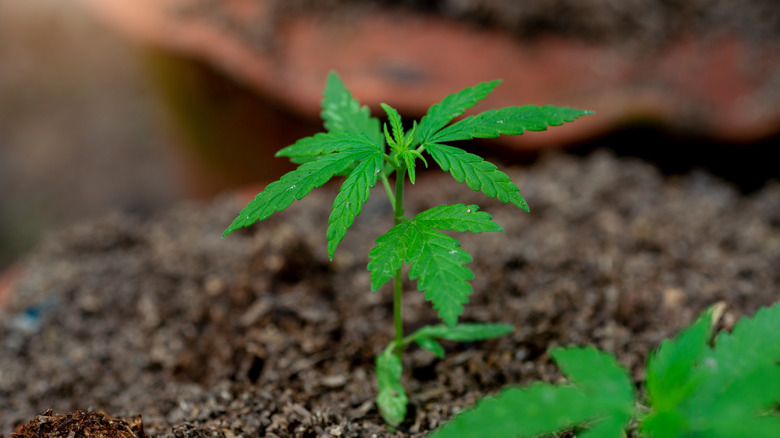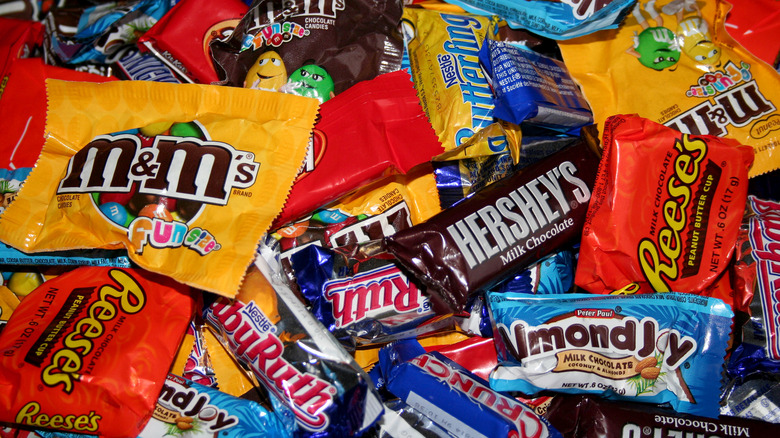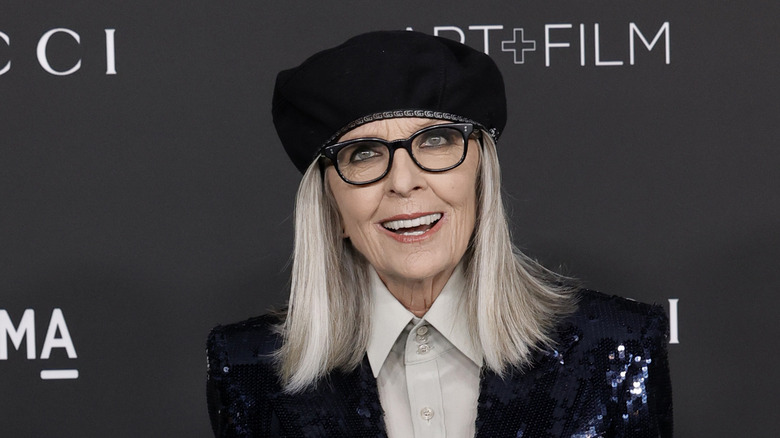The Untold Truth Of Mr. Goodbar
If you've ever purchased a candy bar, you've likely seen the bright yellow packaging containing one of the oldest candy bars in America, Mr. Goodbar. This chocolate and peanut confection has been in existence for nearly a century, helping to make its manufacturer, Hershey, a Fortune 500 company. As of June 2021, the company employs over 16,000 people and is worth over $8 billion.
Some of that $8 billion fortune is due to Mr. Goodbar. This beloved bar is simple, only made of two main parts, but its history and details are a little more complex. Its name has been at the center of various lawsuits, and it's not exactly the same bar that was being eaten during the Great Depression.
Despite various changes and legal issues, Americans still love Mr. Goodbar, and it's got an interesting past. What makes it so interesting? Read on to find out the untold truth of Mr. Goodbar.
Mr. Goodbar was introduced in 1925
The year 1925 was a big year for Hershey's Candy. For the first time in years, the company unveiled a new candy bar. Per Hershey Archives, in 1908, the company released Hershey's Milk Chocolate with Almonds, and over 15 years later, Mr. Goodbar was invented. The chocolatey sensation filled with crunchy peanuts came on the candy scene thanks to Samuel Hinkle.
Samuel Hinkle, an employee of Hershey, had graduated from Pennsylvania State University just three years prior. Despite having no experience with food chemistry, he joined the Hershey team analyzing the fat, sugar, and milk content in products.
Not long after beginning with the candy company, Hinkle began hiring more staff members and developing recipes. The Mr. Goodbar inventor said in an interview, "We'd been experimenting with a peanut bar, peanuts being a popular product with the American people." Hinkle and Hershey read the American people correctly, as Mr. Goodbar is still a popular candy bar today.
Hinkle's contribution to Hershey didn't end with Mr. Goodbar. Per Harvard Business School, Hinkle also helped develop Krackel, another popular candy bar. He was also instrumental in the creation of Hershey's Chocolate Syrup, which too debuted in 1925, per Hersheyland.
Mr. Goodbar was named after a quote
It was Shakespeare who asked "What's in a name?" While Shakespeare was referring to names of people, he posed a good question, one that many people struggle with while in the process of naming their products. For Hershey's Mr. Goodbar, though, naming the candy wasn't so much of a process as it was happenstance.
The candy's inventor, Samuel Hinkle, shared the story of how Mr. Goodbar got its name in an interview. He noted, "Actually, it was Mr. Hershey who really came up with the name. Someone said, 'That's a good bar.' And his (Mr. Hershey's) hearing being a little bad, he thought they said, Mr. Goodbar. So he named it Mr. Goodbar."
The name stuck, obviously, and it hasn't been subject to any criticism since hitting the market in 1925 (except, perhaps, by those who don't like the candy bar), unlike another popular Hershey candy bar. In early 2021, a viral meme sparked a rumor that Payday was undergoing a name change, claiming that some buyers find the name offensive to those who are unemployed. Snopes did what they do best and quashed the rumor, reminding readers that memes are not always to be trusted.
Mr. Goodbar was lunch for some during the Great Depression
In most economies, even the most dire, candy still sells, which proved to be the case for Hershey during the Great Depression. As noted in the Hershey archives, Milton Hershey said, "As far as I know, no man was dropped by reason of the Depression, and no salaries were cut."
Part of Hershey's sustained success came from Mr. Goodbar. Sales are only as good as your marketing tactic, and Hershey employed a unique branding to sell their chocolate and peanut confection. Per the archives, Hershey advertised Mr. Goodbar as a "Tasty Lunch," and priced the bars at two and five cents. Can you imagine buying anything for five cents today?
The marketing idea came from one of the bar's key ingredients: peanuts. The company claimed the nutritional value of peanuts made the bar a suitable option for lunch. As times changed and the economy recovered, Hershey changed their marketing for the bar again, selling them in the '50s and '60s with the tagline, "Quick Energy in Every Bar!"
Mr. Goodbar miniatures debuted in 1939
How do you make a candy bar better? Make it miniature, of course. An appealing bite-sized morsel is nearly impossible to turn down, and one leads to another, after another, after another, after another ... but we digress. We assumed that was Hershey's thought when creating them, but per Hershey's company history, Hershey's miniatures were first created in 1939 for use as samples by salesmen. All of their bars at the time were turned into miniatures, including Mr. Goodbar.
Thankfully, someone at Hershey suggested the miniatures be up for sale, and still today, an assortment close to the original can be purchased. According to Old Time Candy, the only difference between the original assortment and today's is the replacement of the Semi-Sweet chocolate bar with the Special Dark.
Still included in this mouthwatering bag is Hershey's Milk Chocolate, Krackel, and, of course, Mr. Goodbar. The package can be purchased in a few different sizes, including a very large 66.7-ounce bag, boasting over 180 miniature candy bars.
Mr. Goodbar's formula has been changed from the original
Not everything can remain the same, apparently. Not even chocolate bar recipes. If you've spent any time with a Boomer or someone from the Silent Generation, perhaps you've heard some iteration of the phrase "they don't make things like they used to." And while that may just seem like someone yearning for bygone days or bashing the work of today's employers, there is some truth to the sentiment. At least it's true for Mr. Goodbar.
In 2008, consumers noticed a subtle change in the labels of Mr. Goodbar, Krakel, Milk Duds, and other Hershey products. As TODAY reported, the candies are now called "chocolate candy" instead of "milk chocolate," noting that cocoa butter was replaced with vegetable oil. While not everyone was miffed by the formula change, candy connoisseurs, like Cybele May of Candy Blog, were quite unhappy with the difference, claiming to feel as if Hershey's is now selling a subpar product. TODAY added that the change in formula is due to continually rising supply costs.
As of 2021, the formula change is still intact. Per their website, Mr. Goodbar is made with vegetable oil and cocoa butter is not an ingredient.
Mr. Goodbar was involved in a marijuana lawsuit
Like any company, Hershey has seen its highs and lows. In 2014, the company faced a couple lows, and cost others their high. Hershey sued two separate cannabis companies in the same year, both for trademark infringement.
Per Fox 43, Hershey sued Conscious Care Cooperative, a cannabis company out of Washington state, claiming their products too similarly resembled Hershey's candies Reese's and Mr. Goodbar. The products in question? Reefer's Peanut Butter Cup, Kush Peanut Butter Cup, and Mr. Dankbar. What the cannabis company likely saw as clever plays on words, Hershey saw as trademark infringement.
Hershey was also unhappy with Colorado edible marijuana company Tincture Belle, as reported by The Washington Post. Hershey's lawsuit against Tincture Belle stated that some of the edibles sold by the latter company too closely resembled packaging sold by the former. A few separate edibles were named in the case, but some of the standouts were Ganja Joy, seemingly knocking off Almond Joy, and Hasheath, bearing a striking resemblance to Heath bars.
Hershey settled both lawsuits out of court. A Hershey's spokesman, Jeff Beckman, told Reuters of the settlements, "This resolution sends a powerful message to other companies that we are diligent about protecting our valuable brand names and will take action when necessary to protect them."
A woman got sick from eating a moldy Mr. Goodbar
Mr. Goodbar hasn't only been associated with lawsuits for trademark infringement. In 2013, an Alabama woman sued both Hershey and Walmart for selling an expired candy bar, which she claimed was moldy and made her sick after consumption, as reported by AL. The lawsuit noted that she "became violently sick to her stomach and had to leave work and seek medical treatment," and that the candy bar was nine months past its expiration date.
Oddly enough, 2013 wasn't the first time someone has taken legal action after allegedly consuming an unfit Mr. Goodbar. In 1957, Mary Louise Kassouf ate a Mr. Goodbar that she claimed contained worms, and from it developed chronic ulcerative colitis, per Justia. Kassouf maintained that she didn't learn of the worms until having eaten over a third of the candy bar.
In a tragic lawsuit, Mr. Goodbar was mentioned again, this time a mother claiming her son's teacher had fed him the candy bar despite knowing of his severe peanut allergy. "Could have killed him in two minutes," the mother told WTHR of the frightening event.
Mr. Goodbar ingredients come from all over the world
Ever wondered where candy companies source their ingredients? For Hershey, it's all over the world. Although Mr. Goodbar only has two main components, it has far more ingredients, and Hershey gathers substances from around the globe to create this signature candy bar. To make its candy, Hershey needs a large supply of milk. According to an infographic Hershey created to explain, over 17,000 cows are milked each day to make milk chocolate, and the cows are all within 100 miles of the Hershey factory in Pennsylvania. It was because of this choice milk that Milton Hershey built the factory in Pennsylvania to begin with.
For its cocoa, Hershey buys from suppliers in several countries, such as Brazil, Indonesia, Nigeria, and the Dominican Republic. Hershey has stated its commitment to supporting farmers and only using ethically sourced cocoa moving forward.
Mr. Goodbar wouldn't be Mr. Goodbar, of course, without peanuts. Farmers around the United States grow the legumes that are molded into Hershey's candy bars, and the candy company is dedicated to maintaining transparency in its sourcing of peanuts, as well.
There have been calls for boycotts on Mr. Goodbar
Although Mr. Goodbar hasn't been mentioned in lawsuits for years now, it's still been name-dropped in nationwide controversy, mostly revolving around ethics. In a piece published on Medium, light was shed on Hershey's purported sustainability and ethical sourcing efforts, claiming the company has not served on its promises to uphold just practices when gathering its ingredients, particularly those from West Africa. Medium noted that the governments of Cote d'Ivoire and Ghana have both claimed that Hershey has attempted to avoid paying a fee that would aid poverty-stricken farmers, and called upon readers to abstain from buying certain Hershey products, including Mr. Goodbar, in defense of the farmers affected by these actions.
Hershey again came under fire when it, along with Mars, Nestle, and other companies, was sued by eight children who claim to have been illegally enslaved on a cocoa farm, saying the food companies were aiding and abetting the practice, as reported by The Guardian.
A lawyer in the case spoke with The Independent, saying, "These companies are running a war on two fronts." He continued explaining the difference he sees between the companies' statements of commitment to supporting farmers and the ethics of supply chains, and their statements in court, where "they say they are no different from a consumer of a chocolate bar."
Mr. Goodbar is Idaho's favorite candy
Is Mr. Goodbar your favorite candy? Statistically speaking, probably not, but if you live in Idaho or Alabama, it might be. In June 2021, a study conducted by Zippia for National Candy Month revealed that Mr. Goodbar is Idaho's favorite candy, beating out other popular candies like M&M's, Skittles, and Starburst.
The figures depend entirely on how the data is gathered, though. Zippia, for instance, uses Google trends to determine its list, while Candy Store factors its sales to find a winner. The latter determined that both Idaho and Alabama prefer Starburst. We're more interested in knowing why Idahoans and Alabamans have such similar tastes in candy, both by wildly different standards.
Later in 2021, Zippia conducted another study on Americans' favorite Halloween candy by state, and found that Idaho prefers Dum Dums for the holiday, and Alabama favors Skittles. It turns out their specific candy tastes aren't exactly alike.
Mr. Goodbar is mentioned in the title of an Oscar-nominated movie
Mr. Goodbar is a great name. It's so good, other business people and creatives have used it to title their own works. In 1975, author Judith Rossner published a novel called "Looking for Mr. Goodbar," and just two years later a film adaptation of the same name was released, starring Diane Keaton and Richard Gere. The movie was nominated for two Academy Awards, and Keaton was nominated for other awards based on her performance, including a Golden Globe.
The title of the candy bar and the novel is where their similarities begin and end, though. The plot is quite tragic, and makes no mention of the candy bar. Although, Keaton's character does steal them in the film.
Another entity sharing the name, a bar, and restaurant in Buffalo, New York is named Mr. Goodbar. The eaterie has been in business for over 50 years, and was originally named Campus Lounge. The restaurant noted that people thought its name was an homage to the aforementioned film, but they changed to Mr. Goodbar nearly a decade before the movie's release. Apparently, the restaurant's name is not associated with the famed candy bar.











